parking brake Hyundai Equus 2016 Owner's Manual
[x] Cancel search | Manufacturer: HYUNDAI, Model Year: 2016, Model line: Equus, Model: Hyundai Equus 2016Pages: 477, PDF Size: 16.25 MB
Page 17 of 477

Interior features...............3-145
Ashtray ...................................3-145
Cup holder..............................3-146
Sunvisor ..................................3-147
Rear vanity mirror ...............3-147
Power outlet ..........................3-148
Clock ........................................3-149
Clothes hanger......................3-150
Bag hanger ............................3-150
Floor mat anchor(s).............3-150
Luggage net (holder) ..........3-151
Rear curtain...........................3-152
AUX, USB and iPod
®port ..3-153
Multimedia system ...............4-2
Antenna.......................................4-2
Steering wheel audio
control .........................................4-3
Before driving ......................5-5
Before entering vehicle ..........5-5
Necessary inspections ............5-5
Before starting ........................5-5
Engine start/stop button ....5-7
Illuminated Engine Start/Stop
Button..........................................5-7
Engine Start/Stop Button
position........................................5-7
Starting the engine..............5-9
Automatic transmission.....5-11
Automatic transmission
operation ..................................5-12
Good driving practices ..........5-15
Brake system ......................5-17
Power brakes ..........................5-17
Electric parking brake
(EPB)..........................................5-19
Emergency braking ................5-22
AUTO HOLD .............................5-23
Anti-lock brake system
(ABS)..........................................5-26
Electronic stability control
(ESC) ..........................................5-28
Hill-start assist control
(HAC) .........................................5-32
Good braking practices.........5-32
Drive mode integrated
control system....................5-34
DRIVE mode / SNOW mode ..5-34
Electronic controlled
suspension (ECS) ...............5-36
To control the vehicle
height ........................................5-36
ECS (Electronic Controlled
Suspension) malfunction
warning message....................5-37
F17
4Multimedia system
5Driving your vehicle
Page 18 of 477
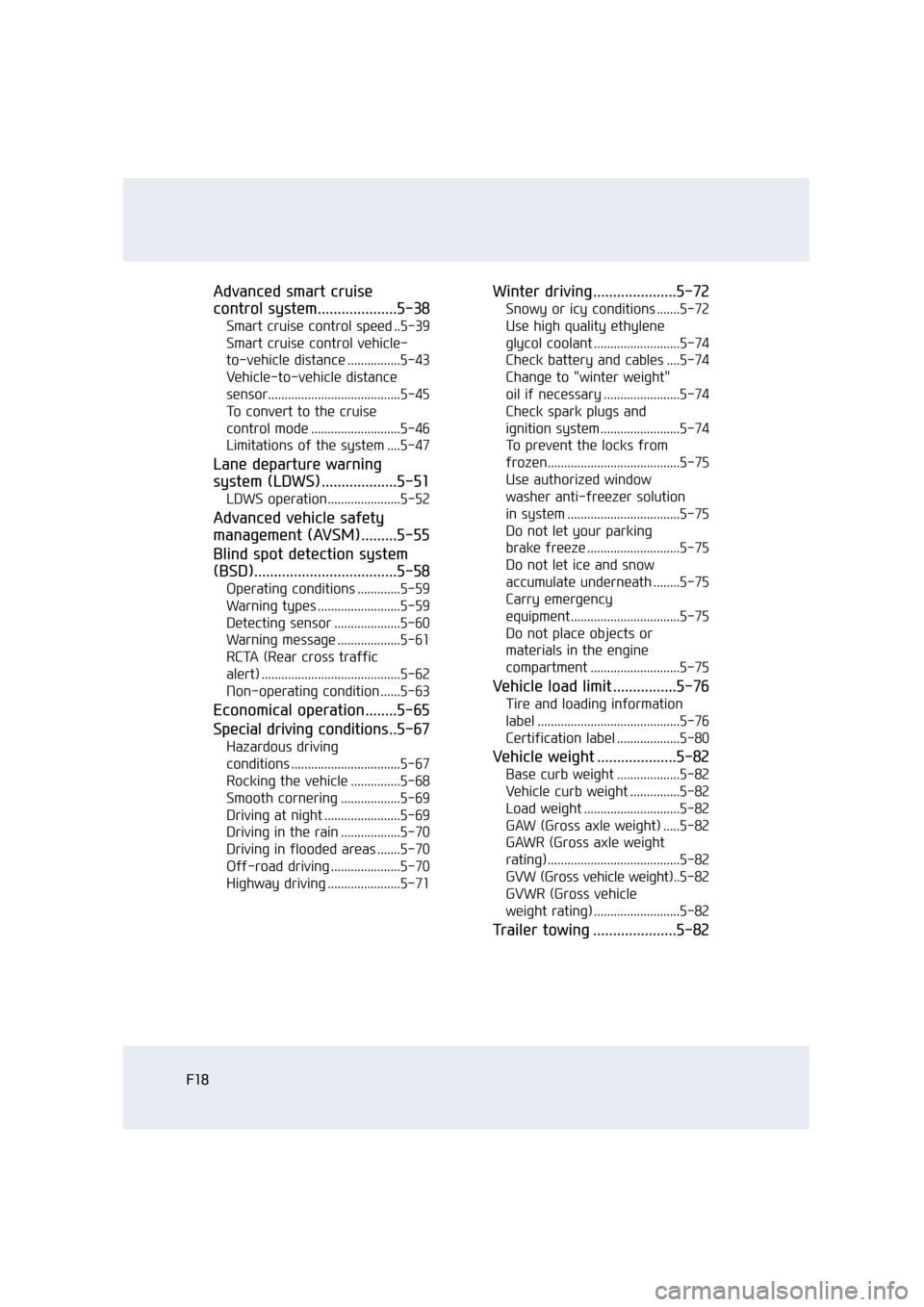
F18
Advanced smart cruise
control system....................5-38
Smart cruise control speed ..5-39
Smart cruise control vehicle-
to-vehicle distance ................5-43
Vehicle-to-vehicle distance
sensor........................................5-45
To convert to the cruise
control mode ...........................5-46
Limitations of the system ....5-47
Lane departure warning
system (LDWS) ...................5-51
LDWS operation......................5-52
Advanced vehicle safety
management (AVSM).........5-55
Blind spot detection system
(BSD)....................................5-58
Operating conditions .............5-59
Warning types .........................5-59
Detecting sensor ....................5-60
Warning message ...................5-61
RCTA (Rear cross traffic
alert) ..........................................5-62
Non-operating condition ......5-63
Economical operation........5-65
Special driving conditions.. 5-67
Hazardous driving
conditions .................................5-67
Rocking the vehicle ...............5-68
Smooth cornering ..................5-69
Driving at night .......................5-69
Driving in the rain ..................5-70
Driving in flooded areas .......5-70
Off-road driving .....................5-70
Highway driving ......................5-71
Winter driving.....................5-72
Snowy or icy conditions .......5-72
Use high quality ethylene
glycol coolant ..........................5-74
Check battery and cables ....5-74
Change to "winter weight"
oil if necessary .......................5-74
Check spark plugs and
ignition system ........................5-74
To prevent the locks from
frozen........................................5-75
Use authorized window
washer anti-freezer solution
in system ..................................5-75
Do not let your parking
brake freeze ............................5-75
Do not let ice and snow
accumulate underneath ........5-75
Carry emergency
equipment.................................5-75
Do not place objects or
materials in the engine
compartment ...........................5-75
Vehicle load limit ................5-76
Tire and loading information
label ...........................................5-76
Certification label ...................5-80
Vehicle weight ....................5-82
Base curb weight ...................5-82
Vehicle curb weight ...............5-82
Load weight .............................5-82
GAW (Gross axle weight) .....5-82
GAWR (Gross axle weight
rating) ........................................5-82
GVW (Gross vehicle weight).. 5-82
GVWR (Gross vehicle
weight rating) ..........................5-82
Trailer towing .....................5-82
Page 25 of 477
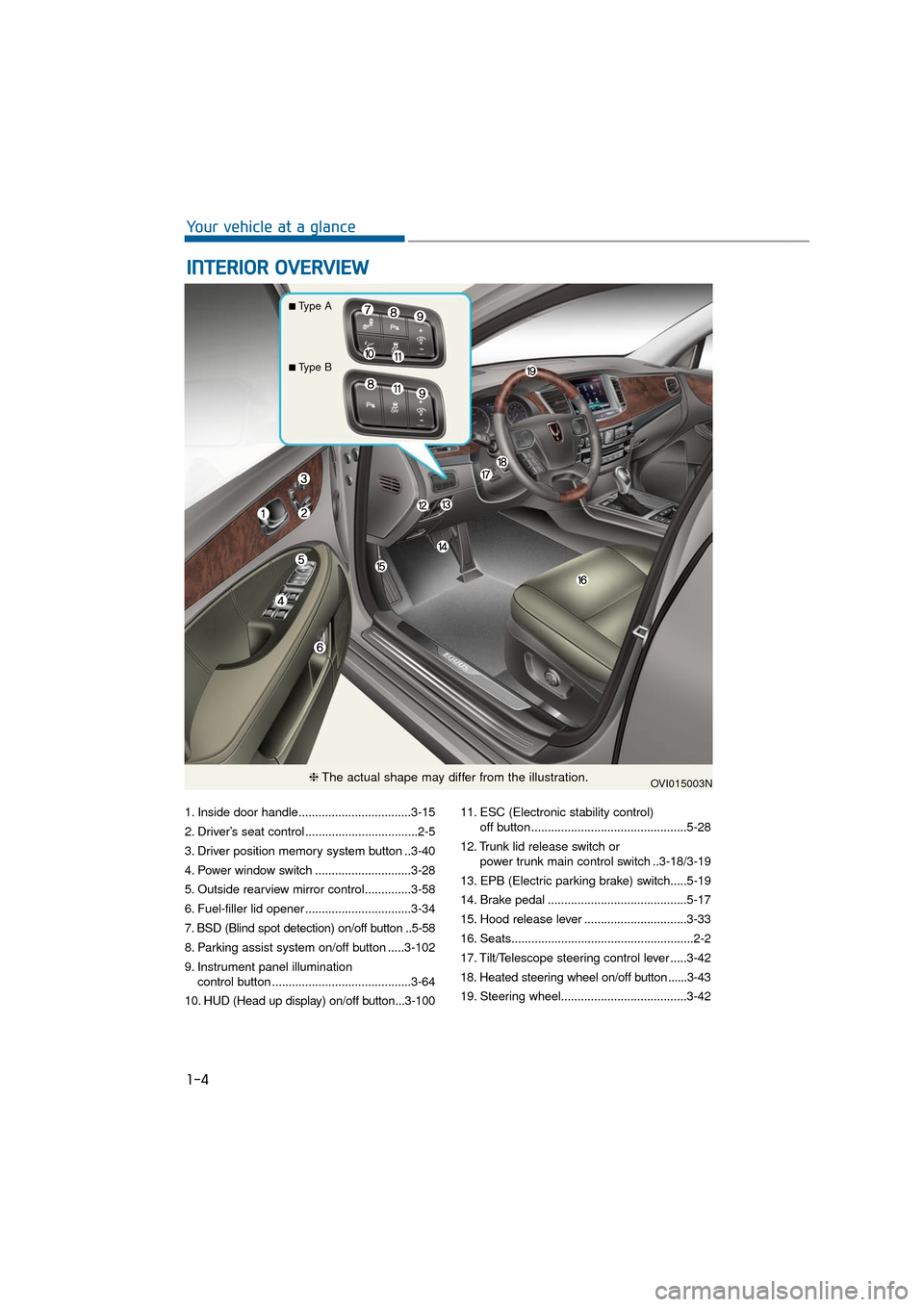
1. Inside door handle..................................3-15
2. Driver’s seat control ..................................2-5
3. Driver position memory system button ..3-40
4. Power window switch .............................3-28
5. Outside rearview mirror control..............3-58
6. Fuel-filler lid opener ................................3-34
7. BSD (Blind spot detection) on/off button ..5-58
8. Parking assist system on/off button .....3-102
9. Instrument panel illumination control button ..........................................3-64
10. HUD (Head up display) on/off button...3-100 11. ESC (Electronic stability control)
off button...............................................5-28
12. Trunk lid release switch or power trunk main control switch ..3-18/3-19
13. EPB (Electric parking brake) switch.....5-19
14. Brake pedal ..........................................5-17
15. Hood release lever ...............................3-33
16. Seats.......................................................2-2
17. Tilt/Telescope steering control lever .....3-42
18. Heated steering wheel on/off button ......3-43
19. Steering wheel......................................3-42
I I N
N T
TE
ER
R I
IO
O R
R
O
O V
VE
ER
R V
V I
IE
E W
W
1-4
Your vehicle at a glance
OVI015003N
■Type A
■Type B
❈ The actual shape may differ from the illustration.
Page 112 of 477
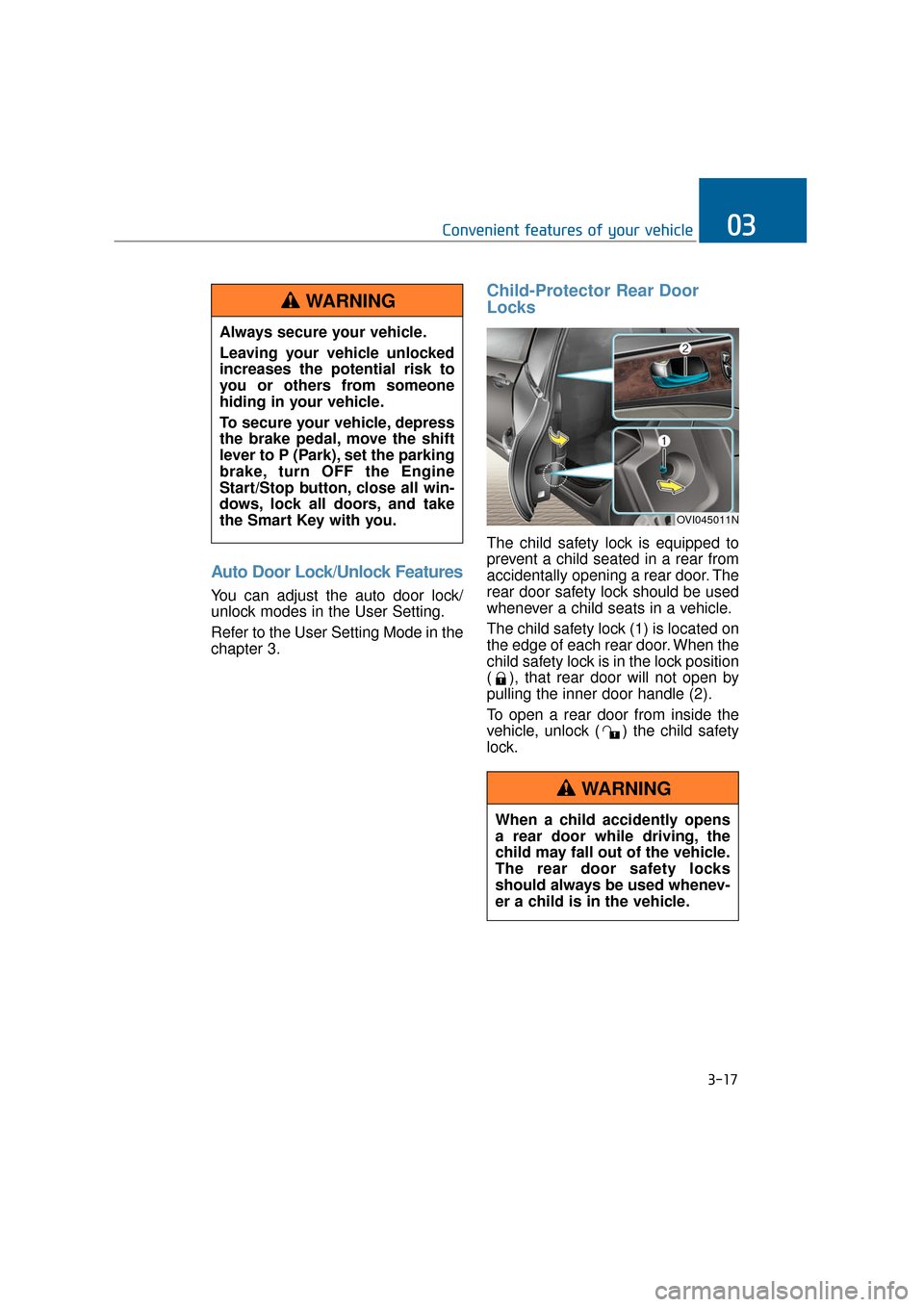
Auto Door Lock/Unlock Features
You can adjust the auto door lock/
unlock modes in the User Setting.
Refer to the User Setting Mode in the
chapter 3.
Child-Protector Rear Door
Locks
The child safety lock is equipped to
prevent a child seated in a rear from
accidentally opening a rear door. The
rear door safety lock should be used
whenever a child seats in a vehicle.
The child safety lock (1) is located on
the edge of each rear door. When the
child safety lock is in the lock position
( ), that rear door will not open by
pulling the inner door handle (2).
To open a rear door from inside the
vehicle, unlock ( ) the child safety
lock.
3-17
Convenient features of your vehicle03
When a child accidently opens
a rear door while driving, the
child may fall out of the vehicle.
The rear door safety locks
should always be used whenev-
er a child is in the vehicle.
WARNING
Always secure your vehicle.
Leaving your vehicle unlocked
increases the potential risk to
you or others from someone
hiding in your vehicle.
To secure your vehicle, depress
the brake pedal, move the shift
lever to P (Park), set the parking
brake, turn OFF the Engine
Start/Stop button, close all win-
dows, lock all doors, and take
the Smart Key with you.
WARNING
OVI045011N
Page 128 of 477
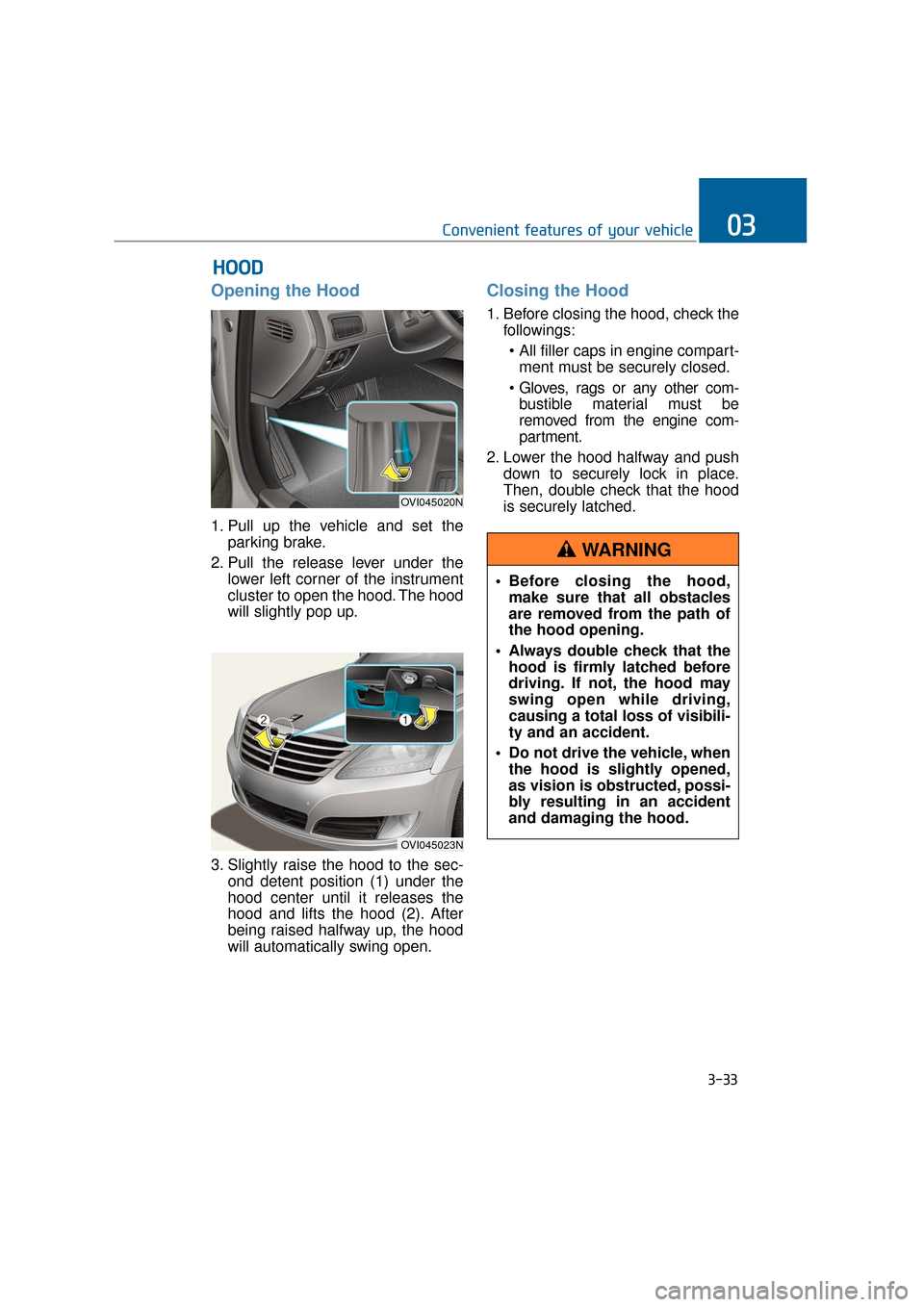
Opening the Hood
1. Pull up the vehicle and set theparking brake.
2. Pull the release lever under the lower left corner of the instrument
cluster to open the hood. The hood
will slightly pop up.
3. Slightly raise the hood to the sec- ond detent position (1) under the
hood center until it releases the
hood and lifts the hood (2). After
being raised halfway up, the hood
will automatically swing open.
Closing the Hood
1. Before closing the hood, check thefollowings:
ment must be securely closed.
bustible material must be
removed from the engine com-
partment.
2. Lower the hood halfway and push down to securely lock in place.
Then, double check that the hood
is securely latched.
H HO
O O
OD
D
3-33
Convenient features of your vehicle03
OVI045020N
OVI045023N
Before closing the hood,
make sure that all obstacles
are removed from the path of
the hood opening.
Always double check that the hood is firmly latched before
driving. If not, the hood may
swing open while driving,
causing a total loss of visibili-
ty and an accident.
Do not drive the vehicle, when the hood is slightly opened,
as vision is obstructed, possi-
bly resulting in an accident
and damaging the hood.
WARNING
Page 130 of 477
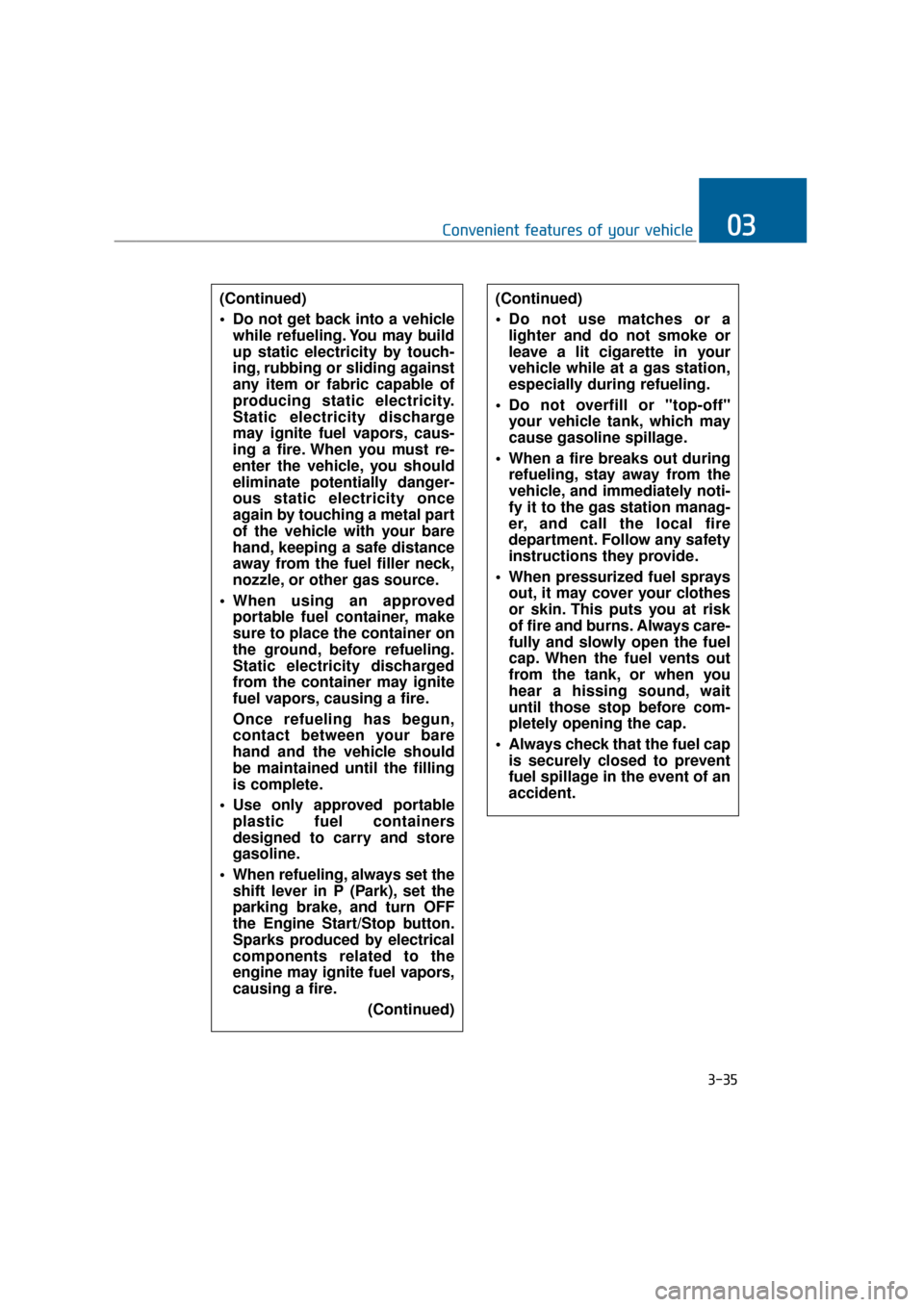
3-35
Convenient features of your vehicle03
(Continued)
Do not get back into a vehiclewhile refueling. You may build
up static electricity by touch-
ing, rubbing or sliding against
any item or fabric capable of
producing static electricity.
Static electricity discharge
may ignite fuel vapors, caus-
ing a fire. When you must re-
enter the vehicle, you should
eliminate potentially danger-
ous static electricity once
again by touching a metal part
of the vehicle with your bare
hand, keeping a safe distance
away from the fuel filler neck,
nozzle, or other gas source.
When using an approved portable fuel container, make
sure to place the container on
the ground, before refueling.
Static electricity discharged
from the container may ignite
fuel vapors, causing a fire.
Once refueling has begun,
contact between your bare
hand and the vehicle should
be maintained until the filling
is complete.
Use only approved portable plastic fuel containers
designed to carry and store
gasoline.
When refueling, always set the shift lever in P (Park), set the
parking brake, and turn OFF
the Engine Start/Stop button.
Sparks produced by electrical
components related to the
engine may ignite fuel vapors,
causing a fire.
(Continued)(Continued)
Do not use matches or alighter and do not smoke or
leave a lit cigarette in your
vehicle while at a gas station,
especially during refueling.
Do not overfill or "top-off" your vehicle tank, which may
cause gasoline spillage.
When a fire breaks out during refueling, stay away from the
vehicle, and immediately noti-
fy it to the gas station manag-
er, and call the local fire
department. Follow any safety
instructions they provide.
When pressurized fuel sprays out, it may cover your clothes
or skin. This puts you at risk
of fire and burns. Always care-
fully and slowly open the fuel
cap. When the fuel vents out
from the tank, or when you
hear a hissing sound, wait
until those stop before com-
pletely opening the cap.
Always check that the fuel cap is securely closed to prevent
fuel spillage in the event of an
accident.
Page 184 of 477
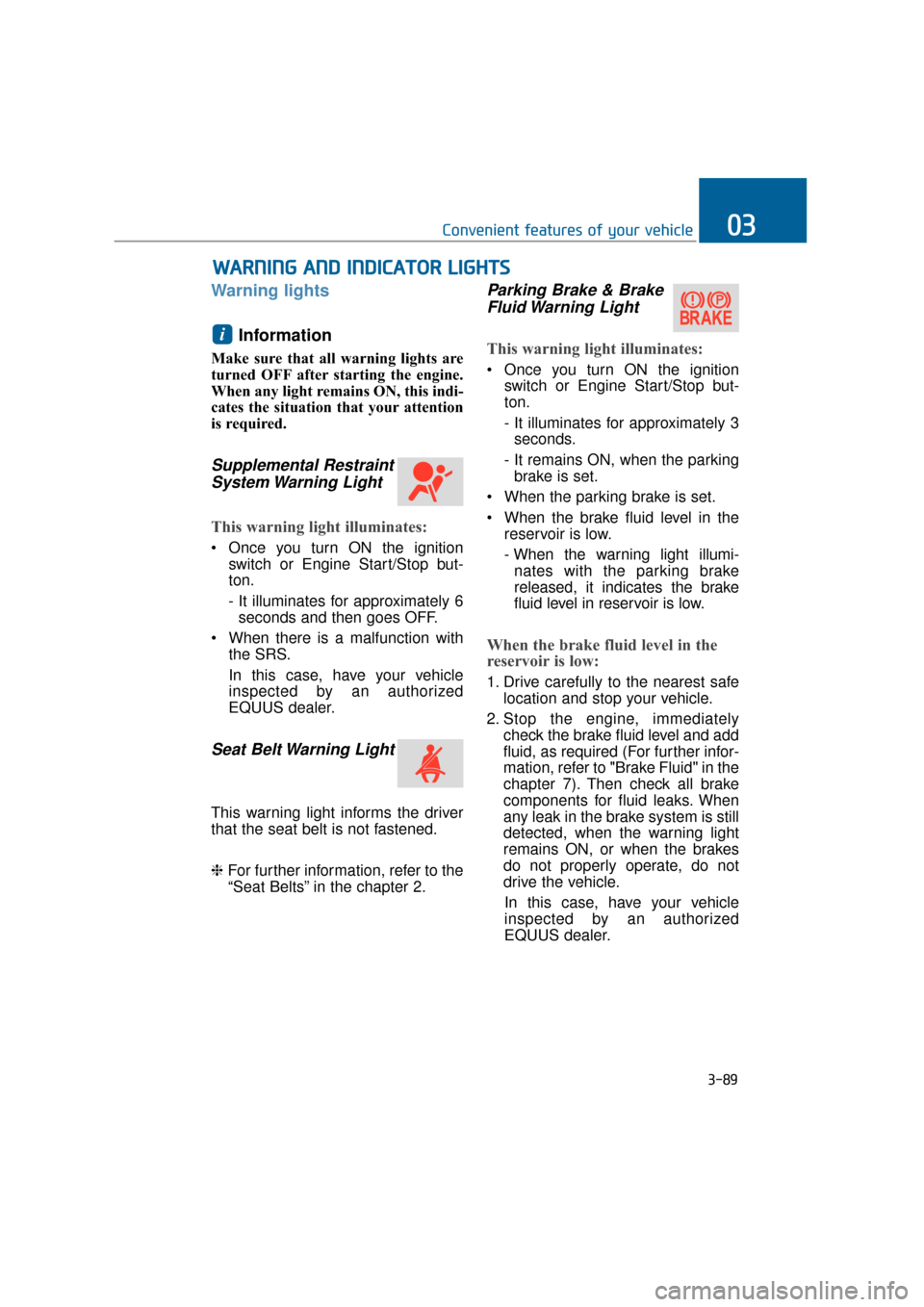
Warning lightsInformation
Make sure that all warning lights are
turned OFF after starting the engine.
When any light remains ON, this indi-
cates the situation that your attention
is required.
Supplemental RestraintSystem Warning Light
This warning light illuminates:
Once you turn ON the ignition
switch or Engine Start/Stop but-
ton.
- It illuminates for approximately 6seconds and then goes OFF.
When there is a malfunction with the SRS.
In this case, have your vehicle
inspected by an authorized
EQUUS dealer.
Seat Belt Warning Light
This warning light informs the driver
that the seat belt is not fastened.
❈For further information, refer to the
“Seat Belts” in the chapter 2.
Parking Brake & Brake
Fluid Warning Light
This warning light illuminates:
Once you turn ON the ignition
switch or Engine Start/Stop but-
ton.
- It illuminates for approximately 3seconds.
- It remains ON, when the parking brake is set.
When the parking brake is set.
When the brake fluid level in the reservoir is low.
- When the warning light illumi-nates with the parking brake
released, it indicates the brake
fluid level in reservoir is low.
When the brake fluid level in the
reservoir is low:
1. Drive carefully to the nearest safe location and stop your vehicle.
2. Stop the engine, immediately check the brake fluid level and add
fluid, as required (For further infor-
mation, refer to "Brake Fluid" in the
chapter 7). Then check all brake
components for fluid leaks. When
any leak in the brake system is still
detected, when the warning light
remains ON, or when the brakes
do not properly operate, do not
drive the vehicle.
In this case, have your vehicle
inspected by an authorized
EQUUS dealer.
i
W W A
AR
RN
N I
IN
N G
G
A
A N
N D
D
I
IN
N D
DI
IC
C A
A T
TO
O R
R
L
L I
IG
G H
H T
TS
S
3-89
Convenient features of your vehicle03
Page 185 of 477
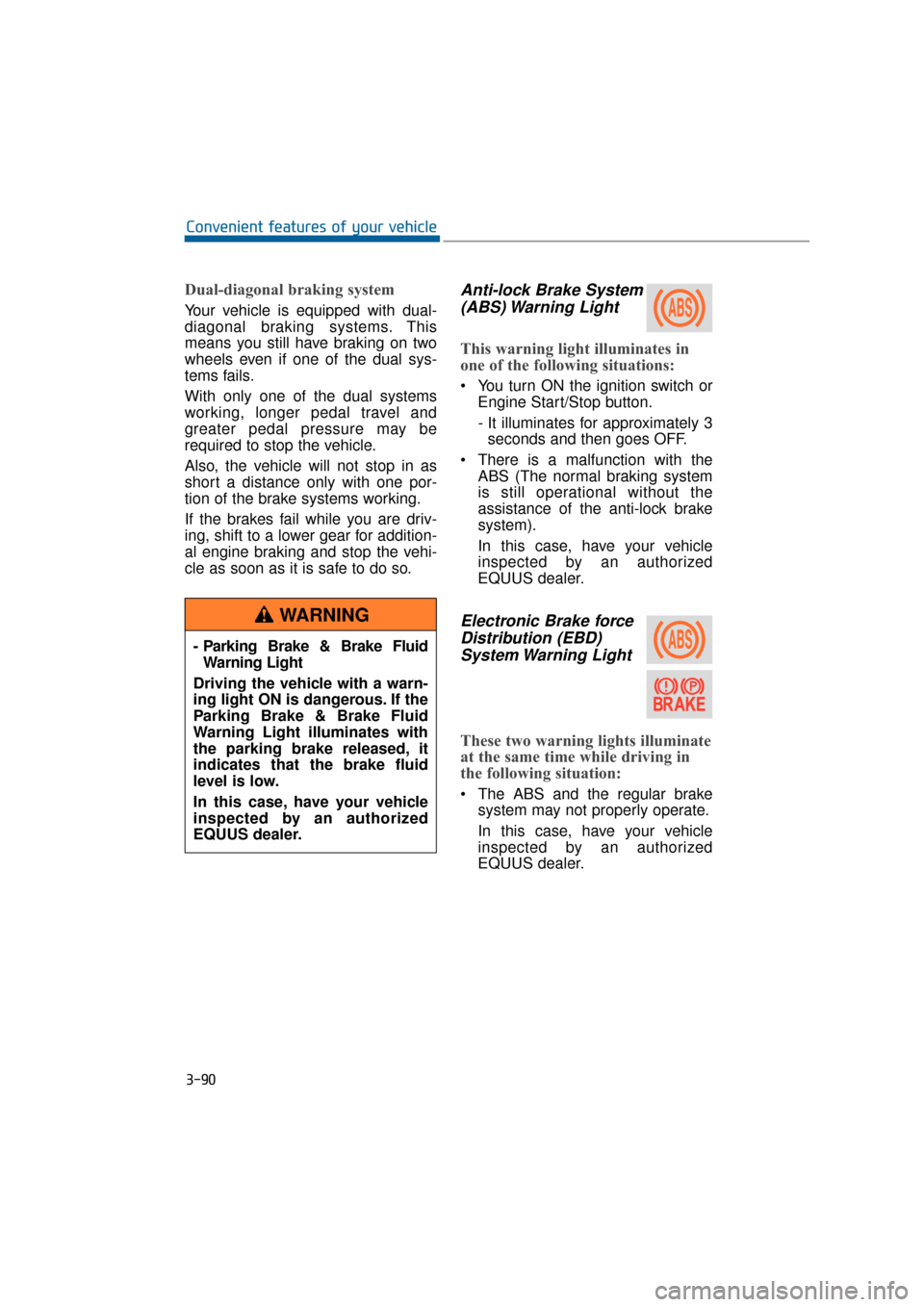
Dual-diagonal braking system
Your vehicle is equipped with dual-
diagonal braking systems. This
means you still have braking on two
wheels even if one of the dual sys-
tems fails.
With only one of the dual systems
working, longer pedal travel and
greater pedal pressure may be
required to stop the vehicle.
Also, the vehicle will not stop in as
short a distance only with one por-
tion of the brake systems working.
If the brakes fail while you are driv-
ing, shift to a lower gear for addition-
al engine braking and stop the vehi-
cle as soon as it is safe to do so.
Anti-lock Brake System(ABS) Warning Light
This warning light illuminates in
one of the following situations:
You turn ON the ignition switch or
Engine Start/Stop button.
- It illuminates for approximately 3seconds and then goes OFF.
There is a malfunction with the ABS (The normal braking system
is still operational without the
assistance of the anti-lock brake
system).
In this case, have your vehicle
inspected by an authorized
EQUUS dealer.
Electronic Brake forceDistribution (EBD)System Warning Light
These two warning lights illuminate
at the same time while driving in
the following situation:
The ABS and the regular brake
system may not properly operate.
In this case, have your vehicle
inspected by an authorized
EQUUS dealer.
3-90
Convenient features of your vehicle
- Parking Brake & Brake Fluid Warning Light
Driving the vehicle with a warn-
ing light ON is dangerous. If the
Parking Brake & Brake Fluid
Warning Light illuminates with
the parking brake released, it
indicates that the brake fluid
level is low.
In this case, have your vehicle
inspected by an authorized
EQUUS dealer.
WARNING
Page 186 of 477
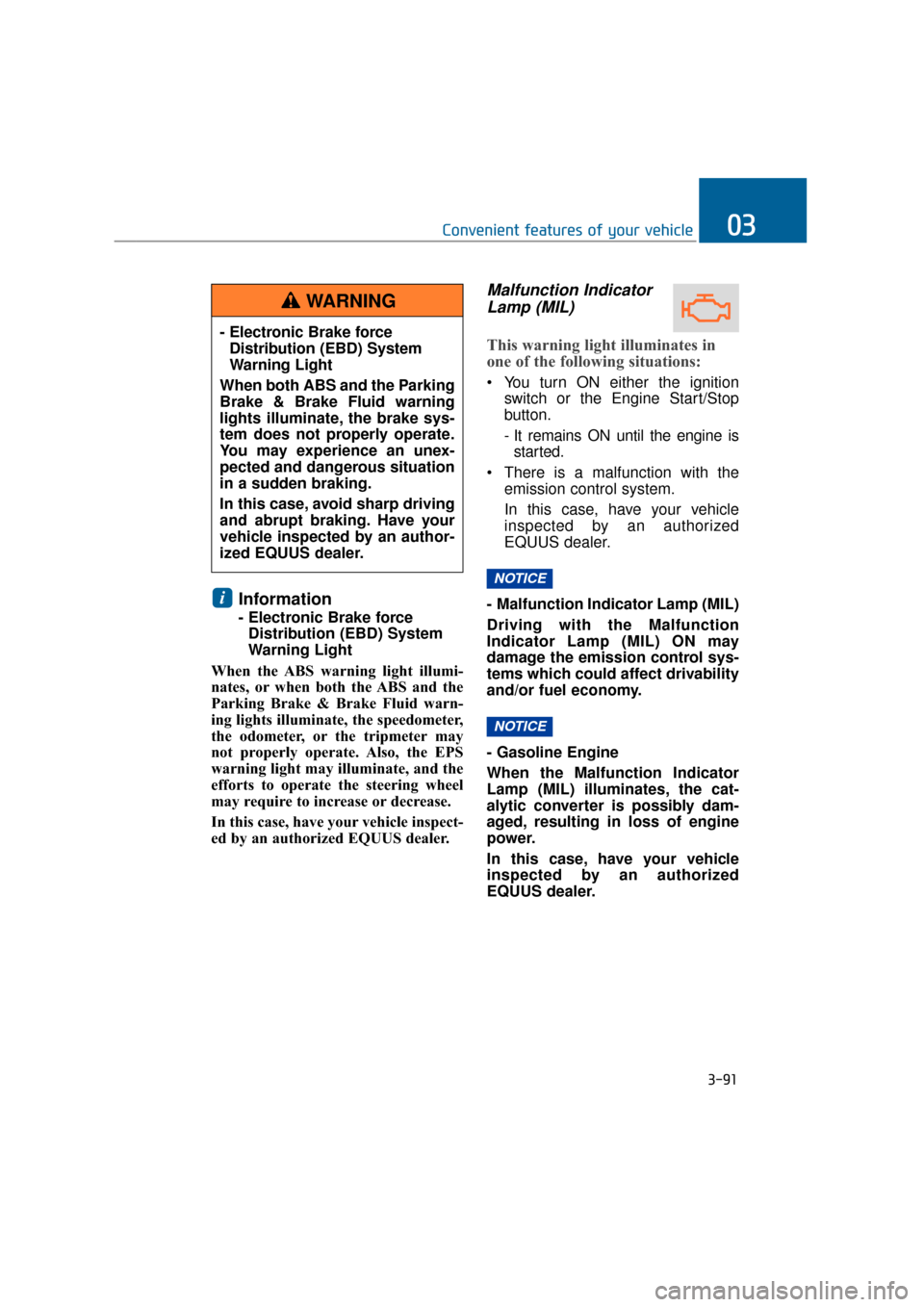
Information
- Electronic Brake forceDistribution (EBD) System
Warning Light
When the ABS warning light illumi-
nates, or when both the ABS and the
Parking Brake & Brake Fluid warn-
ing lights illuminate, the speedometer,
the odometer, or the tripmeter may
not properly operate. Also, the EPS
warning light may illuminate, and the
efforts to operate the steering wheel
may require to increase or decrease.
In this case, have your vehicle inspect-
ed by an authorized EQUUS dealer.
Malfunction Indicator Lamp (MIL)
This warning light illuminates in
one of the following situations:
You turn ON either the ignition
switch or the Engine Start/Stop
button.
- It remains ON until the engine isstarted.
There is a malfunction with the emission control system.
In this case, have your vehicle
inspected by an authorized
EQUUS dealer.
- Malfunction Indicator Lamp (MIL)
Driving with the Malfunction
Indicator Lamp (MIL) ON may
damage the emission control sys-
tems which could affect drivability
and/or fuel economy.
- Gasoline Engine
When the Malfunction Indicator
Lamp (MIL) illuminates, the cat-
alytic converter is possibly dam-
aged, resulting in loss of engine
power.
In this case, have your vehicle
inspected by an authorized
EQUUS dealer.
NOTICE
NOTICE
i
3-91
Convenient features of your vehicle03
- Electronic Brake force Distribution (EBD) System
Warning Light
When both ABS and the Parking
Brake & Brake Fluid warning
lights illuminate, the brake sys-
tem does not properly operate.
You may experience an unex-
pected and dangerous situation
in a sudden braking.
In this case, avoid sharp driving
and abrupt braking. Have your
vehicle inspected by an author-
ized EQUUS dealer.
WARNING
Page 190 of 477
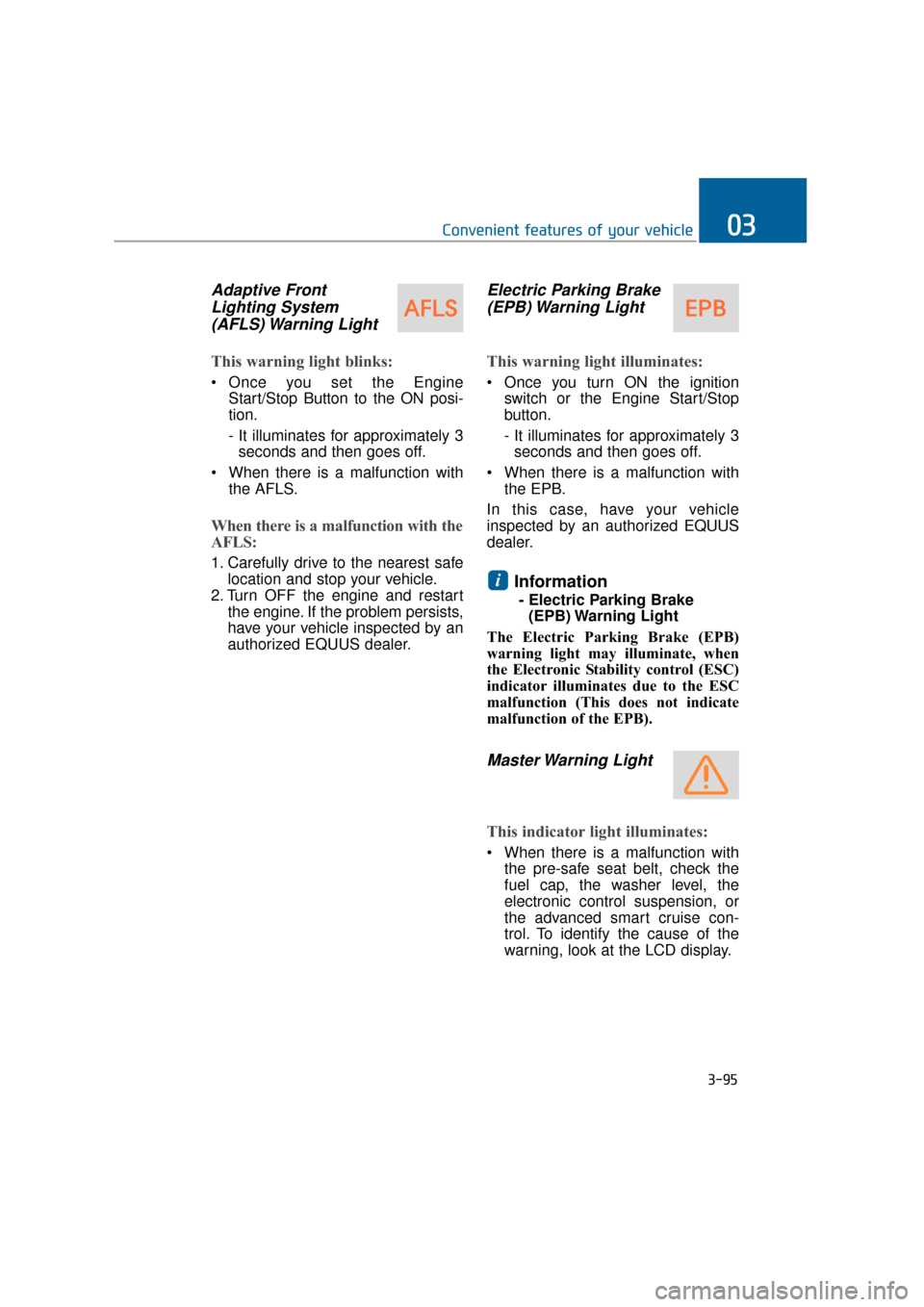
Adaptive FrontLighting System(AFLS) Warning Light
This warning light blinks:
Once you set the Engine
Start/Stop Button to the ON posi-
tion.
- It illuminates for approximately 3seconds and then goes off.
When there is a malfunction with the AFLS.
When there is a malfunction with the
AFLS:
1. Carefully drive to the nearest safelocation and stop your vehicle.
2. Turn OFF the engine and restart the engine. If the problem persists,
have your vehicle inspected by an
authorized EQUUS dealer.
Electric Parking Brake(EPB) Warning Light
This warning light illuminates:
Once you turn ON the ignition
switch or the Engine Start/Stop
button.
- It illuminates for approximately 3seconds and then goes off.
When there is a malfunction with the EPB.
In this case, have your vehicle
inspected by an authorized EQUUS
dealer.
Information
- Electric Parking Brake (EPB) Warning Light
The Electric Parking Brake (EPB)
warning light may illuminate, when
the Electronic Stability control (ESC)
indicator illuminates due to the ESC
malfunction (This does not indicate
malfunction of the EPB).
Master Warning Light
This indicator light illuminates:
When there is a malfunction with the pre-safe seat belt, check the
fuel cap, the washer level, the
electronic control suspension, or
the advanced smart cruise con-
trol. To identify the cause of the
warning, look at the LCD display.
i
3-95
Convenient features of your vehicle03